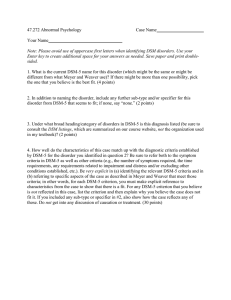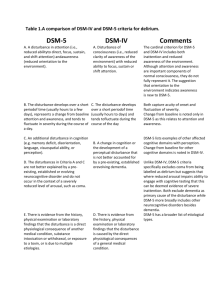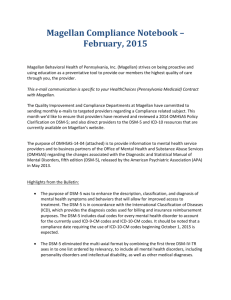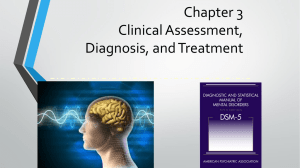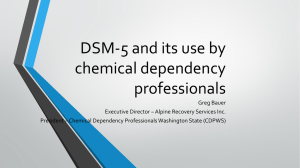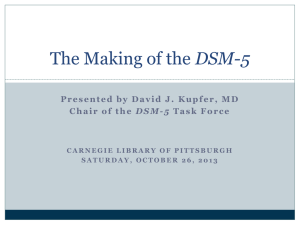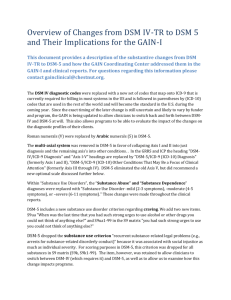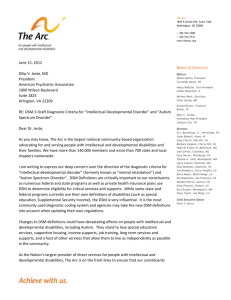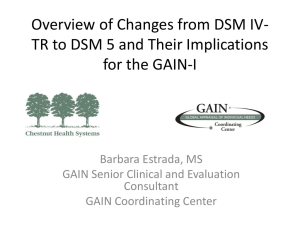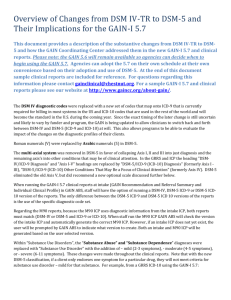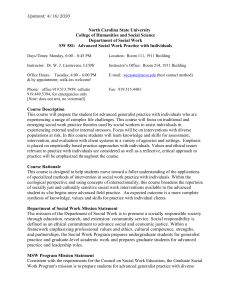New DSM V and ASAM Criteria - Washington State Drug Court
advertisement
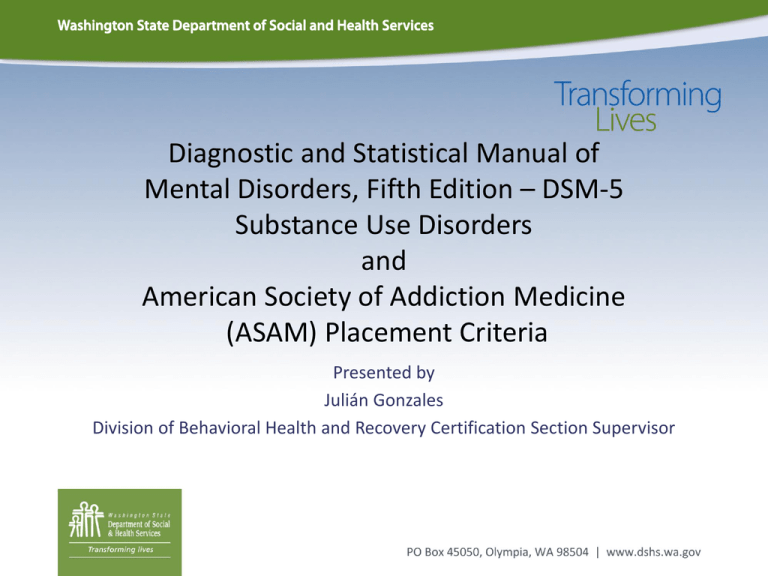
Diagnostic and Statistical Manual of Mental Disorders, Fifth Edition – DSM-5 Substance Use Disorders and American Society of Addiction Medicine (ASAM) Placement Criteria Presented by Julián Gonzales Division of Behavioral Health and Recovery Certification Section Supervisor Purpose and Goals of today’s presentation • Highlight changes in DSM criteria from previous edition to current DSM-5. • ASAM Placement Criteria Standards • Discuss impact of changes for: DBHR Certified Agencies Chemical Dependency Professionals Courts/Corrections/Department of Licensing DSM-5 vs. DSM-IV- TR What changed? • Names of the disorders and the symptoms needed to diagnose the conditions. Substance Dependence and Substance Abuse are no longer valid diagnostic categories. These two conditions are now combined into one called Substance Use Disorder. DSM-5 vs. DSM-IV- TR What changed? • The criteria for diagnosing Substance Use Disorder are now a combination of symptoms that were formerly used to diagnose Substance Dependence and Substance Abuse which are no longer diagnostic categories in DSM-5. DSM-5 vs. DSM-IV- TR What changed? • The number of criteria used to diagnose Substance Use Disorder has changed to a total of 11 criteria. Previously: Four Separate Substance Abuse Symptoms Seven Substance Dependence Symptoms DSM-5 vs. DSM-IV- TR What changed? • Now a minimum of two of the 11 symptoms have to be met to diagnose Substance Use Disorder. 2-3 symptoms = Mild SUD 4-5 symptoms = Moderate SUD 6 or more symptoms = Severe SUD DSM-5 vs. DSM-IV- TR What changed? One Substance Use Disorder symptom, ‘cravings’, has been added to the combined Substance Abuse and Substance Dependence symptoms. One former Substance Abuse criteria, ‘recurrent substance-related legal problems’ has been eliminated. DSM-5 vs. DSM-IV- TR What do these changes mean? • Substance-related legal problems alone are no longer sufficient to diagnose a Substance Use Disorder. • People who were being sent to an Outpatient treatment service based on a diagnosis of Substance Abuse could now be referred to Alcohol/Drug Information School, (education not tx) if they only met one criteria of SA. DSM-5 vs. DSM-IV- TR What do these changes mean? • Persons who have recurrent use in situations that are hazardous to themselves or others meet one of the minimum of two symptoms required to diagnose Substance Use Disorder, as opposed to only needing to meet one for Substance Abuse. Having only one symptom of Substance Use Disorder is insufficient to diagnose the condition. DSM-5 vs. DSM-IV- TR What do these changes mean? • People who were previously diagnosed with Substance Abuse will still be referred to participate in Outpatient treatment, not education, if they meet the diagnostic criteria for Mild (2-3 symptoms) Substance Use Disorder. Meeting one symptom is insufficient to refer the person to treatment. DSM-5 vs. DSM-IV- TR What do these changes mean? • People who were previously diagnosed with Substance Dependence will still be referred to participate in treatment, not education, if they meet the diagnostic criteria for Moderate (4-5 symptoms) or Severe (6 or more) Substance Use Disorder. DSM-5 vs. DSM-IV- TR What do these changes mean? • The Washington State Department of Licensing has already adopted the use of these DSM-5 categories on the Assessment/Treatment reporting form. • DBHR agencies were required to implement the use of DSM-5 as of September 1, 2013. (There is an exemption in effect for Medicaid billing using DSM-IV-TR) DSM-5 vs. DSM-IV- TR What do these changes mean? • Chemical Dependency Professionals in Division of Behavioral Health and Recovery certified programs are required to use American Society of Addiction Medicine Placement Criteria to make patient placement decisions and referrals. They cannot make referrals based on what a patient, attorney or any other person wants. American Society of Addiction Medicine (ASAM) Criteria Treatment Criteria for Addictive, Substance-Related and Co Occurring Conditions The current edition was published and became effective on October 31, 2013 ASAM Dimensions • Dim 1 Acute Intoxication/WD • Dim 2 Biomedical Conditions • Dim 3 Emotional, Behavioral, Cognitive Conditions • Dim 4 Readiness to Change • Dim 5 Relapse, Continued Use/Continued Problem Potential • Dim 6 Recovery/Living Environ Multidimensional Risk Profiles • • • • • Multidimensional / biopsychosocial Relates to the patients history Expressed as current risk status Involves a degree of change Assessment must integrate history, changing situation and current status • Numerical Risk Rating - 0-4 Scale Risk Domains – Dimension 3 • • • • • Dangerousness/Lethality Interference with Recovery Efforts Social Functioning Ability for Self Care Course of Illness Imminent Danger • Probability that certain behaviors will occur • Behaviors which pose risk to self or others • Likelihood of those behaviors occurring in near future Treatment Levels ASAM Levels of Care: • Level 0.5 – Education/Early Intervention • Level I – Outpatient • Level II.1 – Intensive Outpatient • Level III.1/3/5/7 – Residential RH/LTC/IIP • Level IV – Medically Managed IIP Diagnosis • ASAM Criteria recommends the use of Diagnostic and Statistical Manual of Mental Disorders (DSM) in making diagnostic statements What’s Next? • DBHR Certification/Licensing survey staff will be reviewing certified programs for compliance with these diagnostic and placement criteria. What’s Next? • Agencies/Administrators/CDP’s will be held accountable to make clinical decisions based on these criteria. • Compliance with these criteria is mandatory, not optional. Failure to comply will result in deficiencies requiring corrective action. What’s Next? • Failure on the part of agencies or clinical staff to follow these rules can result in corrective action, fines, suspension or revocation of agency certification and the referral of noncomplying clinicians to the Department of Health for negligence, incompetence and unprofessional conduct. Conclusion When addressing the issue of persons driving under the influence or engaging in other illegal actions, certified agencies, CDP’s, the courts and DOL need to work together to make sure patients are accurately diagnosed, referred and treated in order to promote public health and safety, and to ensure accountability for behavior. We are the safety net. Contact Information Julián Gonzales, Supervisor Certification Section Division of Behavioral Health and Recovery julian.gonzales@dshs.wa.gov (360) 725-3730 1-877-301-4557
